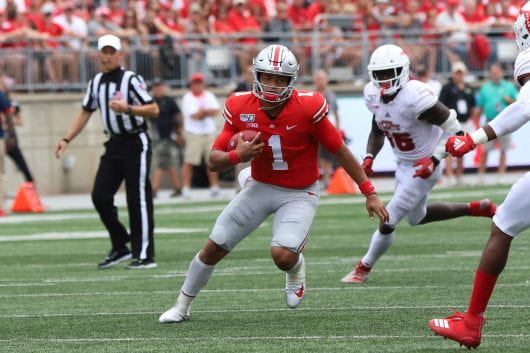
Ohio State sophomore quarterback Justin Fields (1) runs the ball down the field during the second half of the game against Florida Atlantic on Aug. 31. Ohio State won 45-21. Credit: Amal Saeed | Photo Editor
Justin Fields has thrown for six touchdowns and run for three more in his first two games at Ohio State –– four of which have gone for 25-plus yards.
Despite Fields’ penchant for explosive spontaneity, head coach Ryan Day said his favorite play the sophomore quarterback made against Florida Atlantic was throwing the ball out of bounds on a third down.
Fields’ improvisational skills will likely lead to a litany of highlight reel plays for the Buckeyes, but they also require schematic modifications the Ohio State offensive players and coaches must adapt to.
“The ball came out with a little bit more rhythm last year with Dwayne [Haskins] –– three steps and a hitch, the ball came out, checked it down, we were on with the next play,” Day said. “Here, those guys got to stay alive. I think we’re getting a feel for it. Certainly we don’t want to throw the ball down the field late in the middle of the field. We got to be smart with that.”
Whether on designed runs out of the shotgun, quarterback keepers from the read option, or scrambles on broken plays, Fields has carried the ball 21 times through two games.
It took Haskins, who running backs coach Tony Alford said made decisions more “on time” than Fields, seven games to match Fields’ early season carry mark.
But Fields isn’t only looking to run when he escapes the pocket.
On a first quarter scramble against Cincinnati, Fields took what Day called a “bad sack” when he was rocked on a blindside hit while looking for an open man down field.
“When I took that sack, that just was dumb,” Fields said. “I was just sitting back there way too long.”
With the quick delivery of Haskins, redshirt senior wide receiver K.J. Hill flourished this past season, catching a team second-best and career-high 70 passes for 885 yards.
Hill hauled in eight receptions against Cincinnati, but he and the Buckeye receiving corps had to do more work to get open on broken plays than they were accustomed to last season.
“We just gotta keep practicing it,” Hill said. “It’s something we gotta get used to because he’s always keeping his eyes down the field. Plus it’s just more yards for the receiver.”
Defenses will have to respect Fields’ running ability, which he said will open up the field for junior running back J.K. Dobbins, who ran for 141 yards and two scores on 17 carries against Cincinnati.
While Haskins wasn’t much of a run threat, J.T. Barrett ran for 798 yards and 12 touchdowns in 2017–– Dobbins’ true freshman year in which he ran for a career-high 1,403 yards.
Alford said Barrett’s skillset on the ground and decision-making on option reads is at least partially responsible for Dobbins’ freshman success, before a near-400 yard downtick with Haskins at quarterback.
Fields certainly has the running ability, but Day said his reads “could be better.”
Alford said he’s hopeful that Fields and Dobbins can develop the same chemistry his star running back shared with Barrett in their lone season together.
With a quarterback prone to biding extra time with his feet, Alford said more emphasis is placed on pass protection, and his running backs have to adapt to sustaining their blocks longer.
Alford said he’s “not happy at all” with the hits his running backs have allowed on Fields through two games, but Day still seemed to put the onus on his quarterback for Saturday’s sack.
Day may be drilling ball security and risk management into Fields’ head while the team adjusts to his style of play, but the first-year head coach knows he only has so much rein over his playmaking instincts on the field.
“Again, can you really control all of it? No, you can’t,” Day said. “You got to kind of let it go. Give him certain parameters, then trust him.”


